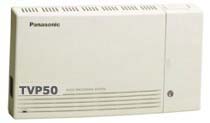|
|
|

|
-
Fourth
model in highly successful KX-TVPseries, at amazing
low price.
- Does
all the tricks of its big brothers, and a few new tricks.
-
2
ports, 32 mailboxes, 2 or 4 hours recording time.
COMMENTS
& TIPS
- Most
important comment:
voice quality is fine; maybe not quite as good as on
the much-more-costly hard drive voice processors, but
certainly good enough. The medium is not affecting the
message very much.
- Most
important surprise: two VP50s can be connected to
one KX-TA624, for a low price 4-port setup.
- Most
unexpected pleasure: CD-ROM manual with hyperlinks.
- Most
unexpected advantage of flash memory: faster turn-on
of message lights.
- Best
thing about the VP50: low price.
- Coolest
thing about the VP50: Caller ID tricks.
- Weirdest
thing about the VP50: manual for KX-TA624 is on
the VS50 CD-ROM.
- Worst
thing about the VP50: choice of actress for prepared
messages ("system prompts"); she sounds like a whore
in a hurry.
- Biggest
Blooper: Instructions for "DIP" switch are confusing.
- The
50 is full of features, but very small, physically.
Even though the housing is the same as the one used
for the KX-TVP75 and KX-TD308, it seemed smaller, maybe
because the packaging is more compact. Panasonic supplies
the 50 in a double box, but the total package is still
small -- about the same size as a 7400-series phone.
- Serial
port connector is a male DB9, pointed downward and usable
with the cover on; unlike the VP75 which has a female
DB25 which is usable only when the cover is off.
- I
can understand changing the location and size of the
connector, but why change the gender? I've long been
annoyed by the lack of standardization among Panasonic
products -- such as the serial connectors on the KX-TD1232
and KX-TVP100 facing in different directions; and now
we have two similar voice processors with connectors
that serve the same purpose, but have different positions,
sizes and genders. Why should installers have to carry
a collection of cables and adapters?
- The
panel beneath the small cover on the right side of the
unit has been re-designed from the VP75, to include
a ferrite core to surround the line cord. We heard no
difference with it and without it. Apparently it's supposed
to keep noise from leaking out, not leaking in.
- The
jacks and ground connection have been moved, but we
still get a label telling us that the unit "must be
earthed." Here in the USA -- the country that won
the war with England -- that's called "grounded."
- You
can probably use a 25-pin null-modem adapter with a
gender changer and 25-to-9-pin adapter, but we wanted
to minimize potential foul-ups, so we used a 9-pin female-to-female
serial cable, and a 9-pin null modem adapter from RatShack.
You'll have to remove some itty-bitty hardware to plug
it into the VP50. Watch out for un-needed couplers on
the end of the cable that goes in to the PC, too.
 |
TIP:
Instead of mounting your voice processing system
next to the phone system control unit, mount it
near one of your computers, so it's easy to make
programming changes. It won't take up much space,
and the wiring is very simple -- much simpler than
extending a serial cable 50 feet. |
- One
reason the box is so small is that there is no suicide-inspiring
400-page manual packed inside. Instead, you get a
small printed subscriber's guide and a CD-ROM, which
strangely includes a 390-page installation manual
and a 214-page user manual -- for the KX-TA624 control
unit.
- The
VP50 manual is provided in two formats: Adobe
Acrobat PDF and web-style HTML, just like the CD-ROMs
now supplied with the bigger VPSes. It's well-organized
and gets a B+ for user-friendliness.
- The
white and yellow Times Roman tiny type on black and
blue backgrounds violates basic design principles
and makes the contents pages look like they came from
a low-budget porno website.
- On
the other hand, the actual instruction pages have
nice black type on white background, with clear tables
and diagrams, clearly-defined section breaks, and
-- WOW -- hyperlinks that will open other windows
to show related sections.
- You
can click all over the on-screen manual, and easily
go between manual and HyperTerminal, or whatever software
you are using to program the TVP50. This is the way
learning and set-up should be done... and it
sure beats flipping paper pages and sticking in paperclips
and Post-it notes.
- Unfortunately,
the instructions still have remnants of "Ancient Japlish",
that should have been fixed years ago.
- There
are lots of mentions of "PBX" systems, but we're supposed
to call Pana systems "hybrids." Silly and sloppy.
- We
recommend the you follow the sequence on the print
a paper copy of the manual to keep as insurance. We're
working on a VP50-specific web page.
- If
you have experience with Panasonic's other Voice Processors,
there is less need to print the manual.
- Section
3.2.3 of the manual strangely refers to connecting
the VP50 directly to phone company CO lines. The manual
for bigger systems mentions this, too; but we never
noticed it before. Weird. More on this later.
- Instead
of the micro-size rotary switch used on the other
voice processors, the 50 uses a "DIP" (dual inline
pin) switch assembly, with four tiny switches that
can be set for either of two positions (zero or one).
Unfortunately, the instructions (Section 4.3.1 and
perhaps other places) refer to "position 5." This
is not like the position 5 on the rotary switches
used in the other systems, but refers to a pattern
of flipping the individual DIP switches, shown on
page 18 of the PDF manual.
- Access
the "Message Manager's Main Command Menu": dial
the intercom number for the voice processing
system, then #, 6, *, 998.
- Press
[5] to modify messages.
- Press
[6] to modify the user prompts,
- Press
[1] to change a specific prompt .
- Enter
the prompt number you want to change.
Prompt 819 is "welcome to the voice processing
system." 248 is "good afternoon." 249 is "good
evening." 250 is "good morning."
- Continue
following instructions.
- NOTE: by eliminating the pre-recorded prompts,
you will cause a delay between the end of ringing
and the first sound that callers will hear.
To minimize the delay, we recommend that you
replace prompt 819 with your own brief message
("Thank you for calling Acme International")
which will be be played immediately before your
main menu (usually "custom 1"). Thanks
to Panasonic techwizard Rich for this tip.
|
- There's
another advantage to making this initial recording:
If there is an emergency or temporary change
in your company's schedule, you can call in from anywhere
and change the opening message to something like "Thank
you for calling Honest Charlie's Used Cars. Because
of Hurricane Hilda, we will be closed until Wednesday,"
but you won't have to re-record your big main menu.
- The
lack of moving parts seems to have speeded up operation.
The Message Waiting light is illuminated less than
a second after a caller hangs up after leaving a message,
and the port is quickly available for the next cal
|
|
|
FACTS
-
The
new KX-TVP50 has all of the features of the popular KX-TVP
series systems, and is much less expensive.
-
It
has solid-state "flash" memory, instead of a hard drive.
Total recording time is two hours. An expansion module
(KX-TVP52) adds two more hours.
-
It
has two "ports" -- it can handle two simultaneous conversations,
including people calling from the outside as well as people
inside checking messages.
-
The
unit is designed for Panasonic KX-TD and KX-TA phone systems,
but can work with any phone system that can handle single-line
analog phones.
-
When
connected to a Panasonic KX-TD digital system, one digital
extension ("station") circuit can send two simultaneous
calls to the KX-TVP50 (except for earliest KX-TD systems).
-
It
can answer your calls as an automated attendant and then
route each caller to the appropriate person or department,
based on touch-tone key strokes.
-
If
no one's available to speak to a caller, he or she can automatically
be sent to voice mail.
-
The
system supports 32 password-protected mailboxes, which can
hold up to 100 messages each.
-
Each
mailbox owner can record a general message, a message for
"after hours" use, and a "busy" greeting that lets the caller
know if they're on the telephone or away from their desk.
-
Through
the system's Enhanced Message Notification, your telephone
can be programmed to:
(1) notify your pager, alerting you to call your mailbox,
(2) display the number of the caller on your pager, or even
(3) call a pre-determined telephone number to reach you.
-
If
you don't pick up your messages within a specified time
period, the Automatic Message Forward/Copy Message feature
can be set to instantly move or copy the message to another
person's mailbox for handling.
-
While
at home or in the office, you can use the Live Call Screening
feature to manage your calls. Like a traditional answering
machine, it allows you to hear the message as it's being
left, and then decide to either accept the call or return
the call at a later time.
-
New Caller
ID Name Announce feature plays a pre-recorded message
to verbally identify the caller.
-
New
Caller
ID Personal Greeting feature allows the user to pre-record
up to four different personal greetings and assign each
to specific telephone numbers. Calls from friends and family
get one greeting, for example, while clients and vendors
get others.
-
New
Holiday Service - provides up to 20 custom greetings
for holidays and can be programmed to play the special greetings
on those days.
-
New Caller
ID Routing can assign up to 120 Caller ID numbers to
be routed automatically to a desired extension, mailbox
or custom service.
-
Some
features require a CHIP UPGRADE when used with an
"original" KX-TA624 system.
-
Versatile
Custom Service menus gives callers one-digit access to department
extensions, information announcements or other system features.
-
Interview
Service - allows you to set up a mailbox that will ask questions
and record responses to up to ten questions. Great for after-hours
order taking, B&B reservations, market research, employment
screening.
-
Built-in
fax detection recognizes the fax tone from incoming faxes,
and automatically transfers the call to the designated fax
extension without the need for a dedicated fax line.
|
|
|
|
|
|
|
|
|
|
MUMBAI
OFFICE:
|
Tel no +91 22-414 6263 ( Hunting line )
|
|
SUBURBAN
OFFICE:
|
Tel
no +91 22-533 4800( Hunting line ) |
|

|